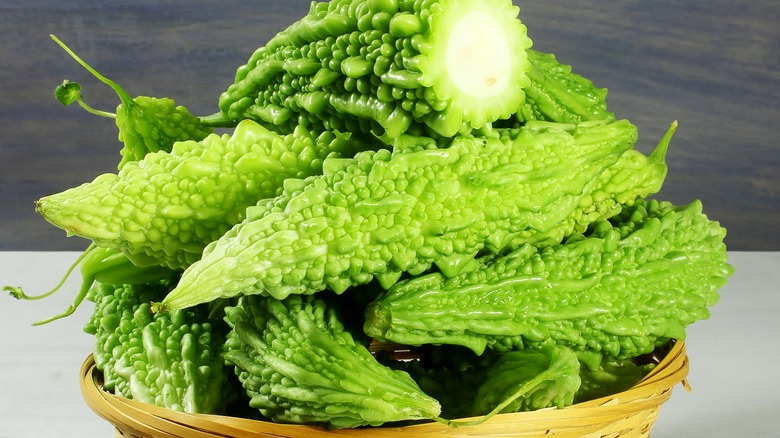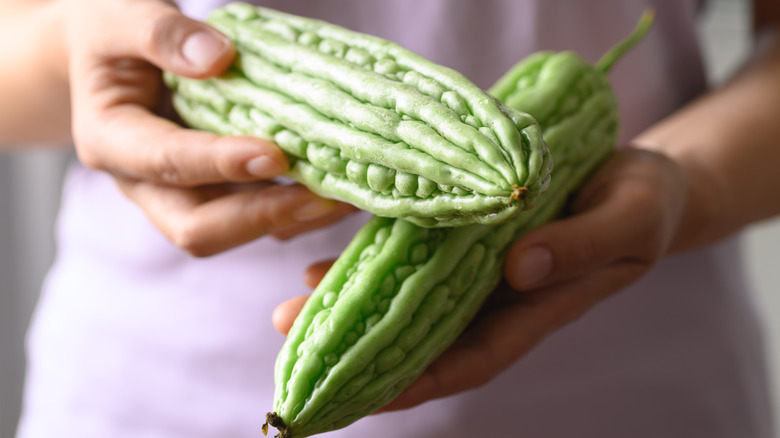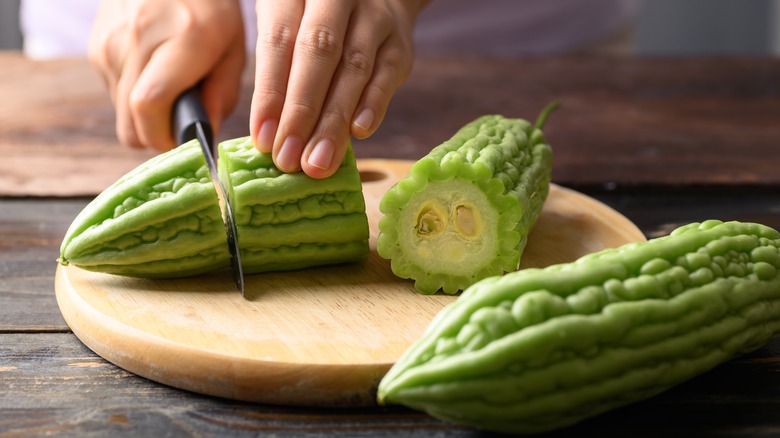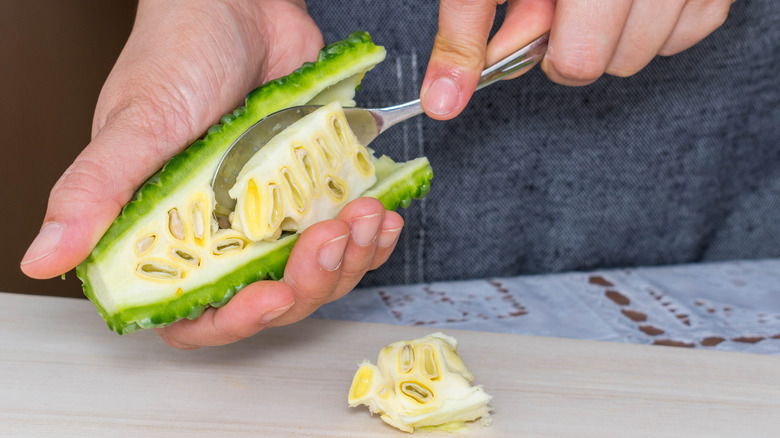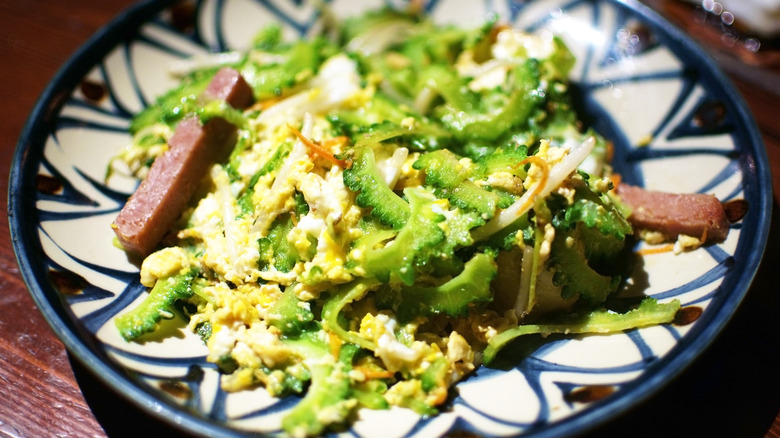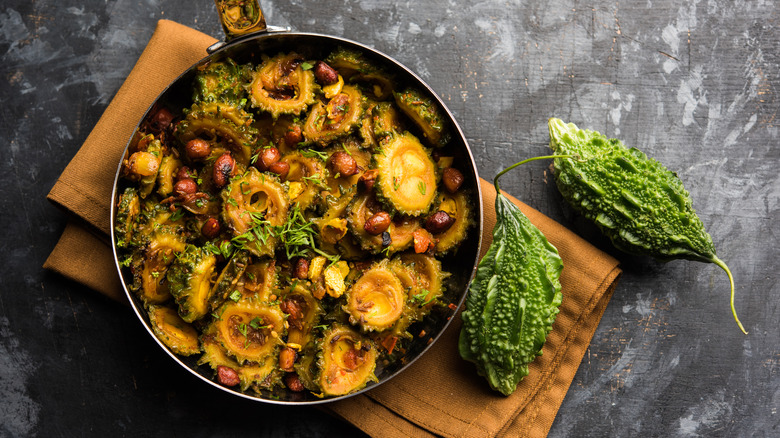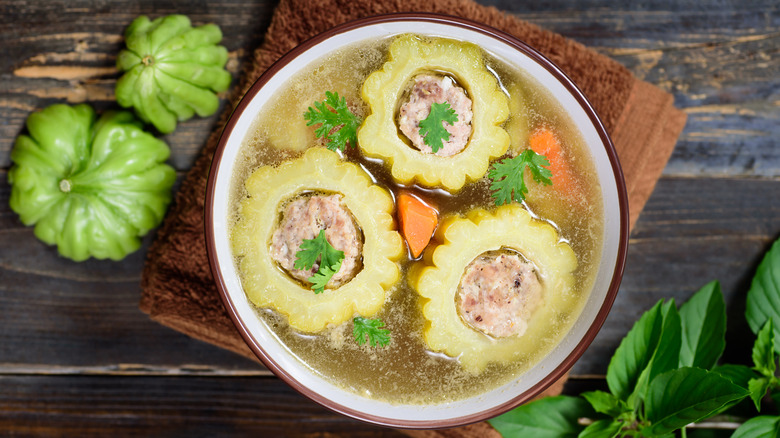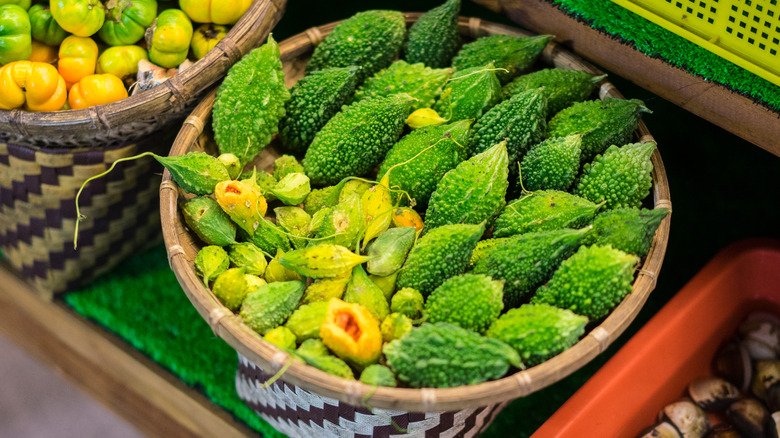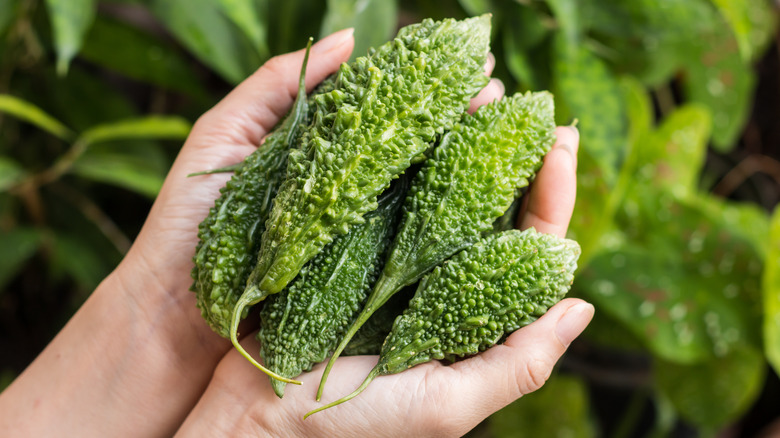What Is Bitter Melon And How Do You Cook It?
Bitter melon (Momordica charantia) is considered to be one of the most bitter natural foods in the world. A fruit by definition, bitter melon is thought of and used as a vegetable, due to the eponymous bitter flavor for which it is named. In fact, it is known by many different names, including goya, nigauri, ampalaya, balsam pear, bitter apple, bitter cucumber, Carilla fruit, bitter gourd, Kerala, ucche, wild cucumber, and many others.
Eaten by millions of people worldwide, bitter melon is a staple in many types of Asian cooking, especially revered in the cuisines of China, India, Japan, and Vietnam, just to name a few. Despite its strong and initially pungent flavor, when cooked right, bitter melon becomes a nuanced ingredient that holds its own with — and enhances other — bold flavors, whether used in Japanese scrambled egg dishes, Punjabi curries, Filipino stir-fries, or Thai soups.
To try and understand why anyone would want to eat something that literally leaves a bitter taste in the mouth, we have to first take a closer look at what bitter melon is, its role in world cuisine, and ways of cooking with it that make the fascinating bitter melon not only easier to swallow but also surprisingly delicious.
What is bitter melon?
The bitter melon is a tropical and subtropical plant that is native to large areas of Asia and Africa. It is a fast-growing, fruit-bearing vine in the Cucurbitaceae family — along with cucumbers, squashes, pumpkins, and other gourds. Bitter melon is grown commercially for food in China, Taiwan, and throughout Southeast Asia.
There are two main varieties of bitter melon used for cooking. Both look a bit like cucumbers but with some significant differences. The Indian bitter melon, known as Kerala, is recognized by its oblong shape and dark green flesh covered in spiky bumps. The Chinese bitter gourd, as it is sometimes called, is longer and thinner, with a light green skin that is smooth with folds and furrows.
While some people claim that the Chinese bitter melon is less bitter than the Indian variety, they taste essentially the same and are used the same way in cooking. Choose smaller, younger bitter melons for the least amount of bitterness, which has yet to fully develop as the fruit matures.
What does bitter melon taste like?
As advertised, bitter melon has a strong, bitter flavor, at times so acrid as to make one's mouth dry just from tasting it. Nothing like fruity melons that grow sweeter as they ripen, this melon will only remain bitter. Choose smaller, younger bitter melons for the least amount of bitterness, which has yet to fully develop as the fruit matures. It can be eaten raw, as in salads; however, some people find it too intensely bitter to be consumed uncooked, as cooking will mellow its flavor.
Bitter melon is crunchy like celery, with a wet interior like a cucumber. The cooked texture can be likened to that of zucchini or chayote squash. Far from being seen as a drawback, the bitterness in bitter melon is welcomed in the cuisines of many cultures that are more acquainted with bitter flavors than the Western palate. While there are some preparation tricks for making the fruit less bitter, some cooks bypass this step altogether, preferring the strong, undiluted flavor to be the star of their dishes.
Bitter melon pairs well with other flavors that either enhance or balance its acerbic punch. Complimentary flavor pairings include curry, garlic, ginger, chili, fermented bean paste, soy sauce, oyster sauce, vinegar, and preserved or pickled fish. The sharpness of the bitter melon can be tempered by cooking with foods that add sweetness, like corn, sweet potatoes, and onions.
How to cook with bitter melon
Bitter melon is eaten worldwide and features heavily in Asian cuisines. It can be used in any number of creative and delicious ways, most popular in stir-fries, in a variety of curries, stuffed with meat and vegetables, or deep-fried crispy.
While the seeds and white pith inside of bitter melon are considered edible, there is conflicting information regarding the toxicity of the seeds in high quantities. Regardless, edible and palatable are not the same things, and the consensus is that those parts are not very tasty. No matter how you choose to cut it, a spoon can be used to reach in and scoop out the pith and seeds. Depending on how the bitter melon will be used, it can be cut in half lengthwise or into hollow circles for stuffing, sliced into half-moons for stir-frying, or chopped into thick sticks for deep-frying.
There are two well-known tips for mellowing the bitter melon's flavor before cooking. The first uses salt to draw out the bitterness. Coat the fruit liberally in salt, place it in a sieve over a bowl or in a colander, and allow it to drain. As the salt sweats the fruit, the water released will remove some of the bitter flavors with it. The second method is to blanch the melon. The pieces or whole fruit are put into boiling water for a couple of minutes, and then quickly rinsed under cold water to stop the cooking process.
Bitter Melon in Asian Cuisine: Japan and China
The Japanese word for bitter melon is nigauri, but on the island of Okinawa, it is known as goya — a name that has become more common. This is likely due to Okinawa being the home of what is inarguably the world's most famous bitter melon dish, goya chanpuru. Enjoyed throughout Japan, China, and in various forms throughout Asia, goya chanpuru is a simple homestyle stir-fry dish of bitter melon and scrambled eggs. It is often made with pork or tofu, and in its most iconic form, with Spam.
The basic recipe for goya chanpuru is made by first pan-frying sliced Spam. Stir-fry the chopped bitter melon in sesame oil until softened, then combine it with the Spam. Add the seasonings, such as soy sauce, oyster sauce, mirin, and sake. Then, mix in beaten eggs and cook it all until set. The finished dish can be garnished with bonito (dried fish flakes).
Along with goya chanpuru being adopted into Chinese cuisine, China has its own bitter melon specialties — where the fruit is known as ku gua. In ku gua niang rou, you cut the gourd into rounds and stuff it with ground pork, vegetables, and mushrooms. Next, pan-sear and braise the mix in garlic-wine-oyster sauce. The name of another classic Chinese dish translates to beef-with-bitter-gourd, in which the melon is stir-fried with strips of seasoned beef, garlic, and douchi (fermented beans with a pungent, salty, umami bomb of flavor).
Bitter Melon in South Asian Cuisine: India, Pakistan, Bangladesh
Bitter melon features prominently in South Asian cooking, especially in North Indian and Punjabi recipes, where it is known as karela. One of the most loved dishes of the region is karela sabzi, a vegetarian bitter melon and onion curry. In bharwa karela, you slice bitter melons in half and stuffed them with spiced, caramelized onion masala. Dahi karela is a Punjabi recipe made with pan-fried bitter melon, onions, and tomatoes, in a sauce of creamy yogurt spiced with turmeric and garam masala. Khatta meetha karela is a sweet and sour preparation of bitter melon cooked with aromatic spices, chiles, sour tamarind, and sweet jaggery (traditional unrefined sugar).
In Pakistan, keema karela is made with chopped and fried bitter melon cooked in yogurt with ground beef, caramelized onions, green chiles, tomatoes, ginger, garlic, turmeric, and cumin. Karela gosht is another traditional Pakistani curry dish of bitter melon cooked with lamb and aromatics. Further east in Bangladesh, where bitter melon is known as ucche, there is a dish called tetor daal. Tetor is the word for bitter in Bengali, and daal means lentils. In this recipe, cook stewed yellow lentils with bitter melon in pungent mustard oil.
Bitter Melon in Southeast Asian Cuisine: Vietnam, Thailand, Indonesia, Philippines
Vietnam's version of stuffed bitter melon comes in the form of a soup called canh khổ qua, made with ground pork, shallots, spring onions, and fish sauce. This soup is traditionally enjoyed for Tet, the Vietnamese lunar New Year holiday. Thailand's herbal chicken soup with bitter melon is called kaeng gai sai ma ra (ma ra is another name for the fruit). Here small pieces of bitter melon and chicken are cooked with a paste of chiles, garlic, aromatic galangal, and lemongrass, along with crushed cilantro, then boiled in a flavorful broth.
In the Philippines, ampalaya is the Tagalog word for bitter melon. Similar to Okinawan goya chanpuru, the Filipino version is called ginisang ampalaya, where in addition to bitter melon and eggs, tomatoes and onions are added. Pinakbet is a stew of vegetables, pork, and traditional Filipino fermented shrimp paste known as bagoong. In Indonesian cooking, the Javanese word for bitter melon is pare. Oseng-oseng pare is another stir-fried bitter melon dish, in this case flavored with garlic, galangal, roasted shrimp paste, and salam (Indonesian bay leaves). It can be prepared with vegetables, meat, or seasoned tempeh. Tumis pare is also flavored with salam and garlic, and can be made with shrimp or eggs, or both.
Where to buy bitter melon
Not usually stocked in American grocery stores, bitter melon can often be found fresh at Indian, Asian, and Middle Eastern specialty markets, Chinatowns, and farmers markets. It can also be ordered online from Amazon where it is occasionally on offer from importers of rare produce. You may even be able to find it at superstores like Walmart occasionally.
Those with green thumbs can try growing their own bitter melon from seeds, which are relatively easy to purchase from nurseries and garden supply stores, or via mail order. The plants grow quickly as ornamental vines and produce attractive flowers. While not used as often in the United States for food as it is in other parts of the world, the unique appearance of the bitter melon makes it useful as a decorative gourd, perfect for creating table centerpieces along with pumpkins and squash for fall holiday displays.
Nutritional information about bitter melon
Aside from its biting flavor, bitter melon has many nutritional benefits that make it an important and desired ingredient. A one-cup serving of bitter melon contains 16 calories, has no fat or cholesterol, and is low in sodium and carbohydrates. It is considerably high in the antioxidant vitamin C (78.1mg), with 87% of the daily recommended intake, and has a fair amount of fiber (2.6g), 9% of the daily recommended amount. It is also a good source of the minerals potassium, phosphorus, and folate (via USDA).
Bitter melon is also used as an herbal medicine believed to help control infections, cancer, and diabetes (per Memorial Sloan Kettering Cancer Center). A 2012 study by the National Institute of Diabetes and Digestive and Kidney Diseases showed that bitter melon extract had promising results in lowering blood sugar, indicating that it could potentially be useful as a treatment for diabetes that works similarly to insulin; however, more research is needed. Bitter melon is not approved by the FDA for any medical uses. As reported by Pregnancy Food Checker, people who are pregnant or breastfeeding are advised against consuming bitter melon, which has teratogenic properties known to cause birth defects and abnormalities in animal studies (via AJTCAM).
While the astringent flavor of bitter melon is an acquired taste, more exposure can turn one from being a hater into a lover of this sometimes-maligned ingredient.

